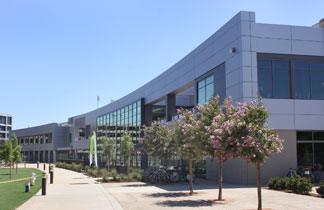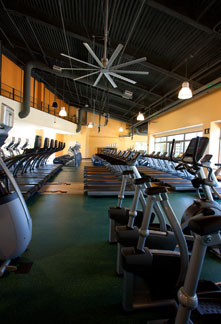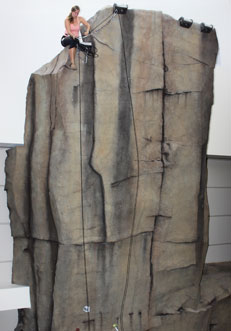$71 Million Rec Center Opens in Calif.

SACRAMENTO, Calif. — Gazing up at the exterior of the two-story glass façade of the recently completed recreation center at Sacramento State University, architect Burt Miller describes the visual experience of seeing the finished product that his company designed, from the outside looking in.
“On the one hand, it appears like a bank of monitors, each window displaying a different scene with a different student working out in it,” says Miller, a principal and senior vice president at the San Francisco-based Hornberger + Worestell design firm.
“On the other hand, it’s like an ant farm with this transparent layer where all the activity is happening immediately behind it, like people coming and going from the lobby, students dining in the café, groups working out in the exercise studios, etc.” he says.
The bottom line, he says, is that the architects and builders achieved exactly what they were trying for when sketching out designs for The WELL (Wellness, Education, Leisure, Lifestyle), a $71 million, 151,000-square-foot recreational facility at Sac State, that is slated to open its  doors in September.
doors in September.
 doors in September.
doors in September.Designers from Hornberger + Worstell, along with Ellerbe Becket of Kansas City, Mo., were aiming for a structure that stood apart from the so-called “warehouses for recreation” that Miller says he and his colleagues witnessed at other California State University campuses.
“On one level, this recreation and wellness center will create a new social nexus for the campus where students, either before, after, or between classes, will have an opportunity gather and workout,” says Miller. “The university also wanted a building that — to use their words — had a ‘Wow!’ factor. They didn’t want to be timid with the structure.”
Historically a commuter-school, it’s been a long-term goal of Sac State to give its students more on-campus activities. Funded by a $50 million CSU system-wide bond and a student fee established in 2004, The WELL is open to students, faculty, staff, and super-alum that paid the fee in past years.
Housing both the recreation department and health services, The WELL replaces several outdated facilities, including the early 1950s-era campus buildings that had previously contained the university’s health department.
Architects designed the building with plenty of transparent walls and a sweeping north face that takes advantage of natural lighting and creates a quad between The WELL and another recently completed structure, the student union building, aptly titled the University Union. On the southwestern end of the rec center are outdoor terraces that overlook Hornet Stadium, the game field for Sac State’s football team. Inside is located the largest climbing wall in the CSU system, an indoor running track, several multipurpose courts and fitness students, racquetball areas, and an attached four-court basketball complex.
The health services department is located at the other end of The WELL, and includes primary and urgent care clinics, a pharmacy and nutrition center, laboratories, imaging services, a preventative health area, and a cooking demonstration room. Peak Adventures, a student outdoor club at Sac State, also has its offices inside the rec center.

Locating the health, recreation departments and the outdoor club in the same facility provided opportunities for collaboration, says Mirjana Gavric, director at The WELL.
“What I find most exciting about this building is the philosophy behind what we’re doing — the integration of health services, the outdoors adventure club, and recreation,” says Gavric. “We’re integrating those three areas in a partnership, and we’re providing a service that’s unique — it’s mind, body, and soul.”
“It’s about students being able to go to the health center and receive a prescription, which might be something like a yoga class or a breathing class in the rec center, or maybe their doctor prescribes an outdoor adventure course,” she says.
Miller added that the close proximity of the recreation and health areas also presented unique design challenges — particularly with regard to designing wellness areas private from those of recreation services.
“On the one hand, the Well has programs and activities that want to reach out and commingle with recreation,” says Miller, “but on the other, [many] people who visit health services are ill and want isolation, or they are there for personal reasons and need some privacy.”
To achieve this environment, wellness areas are located at one end of the building but share meeting spaces and the central lobby with the rec department. Less private areas, like the pharmacy and retail optometrist, are located off of this shared space.
In addition to a building focused on all-things holistic, the facility encourages a healthy environment through its green features. Expected to earn LEED Gold, The WELL incorporates many of the standard sustainable elements found in green buildings, including a high efficiency HVAC system and plenty of daylighting and recycled building materials.
Some of the not-so-common green elements include a lobby floor made of recycled Heineken-bottles and gymnasium paneling created from pressed sunflower seeds. Unique products include a Vector Foiltec skylight system, which features an ETFE film designed to reduce heat gain, and several Big Ass Fans ceiling fans, installed to increase air circulation in The WELL.
The WELL was built by nationwide construction firm McCarthy Building Co. and Tony Moayed Construction Services of Sacramento.
